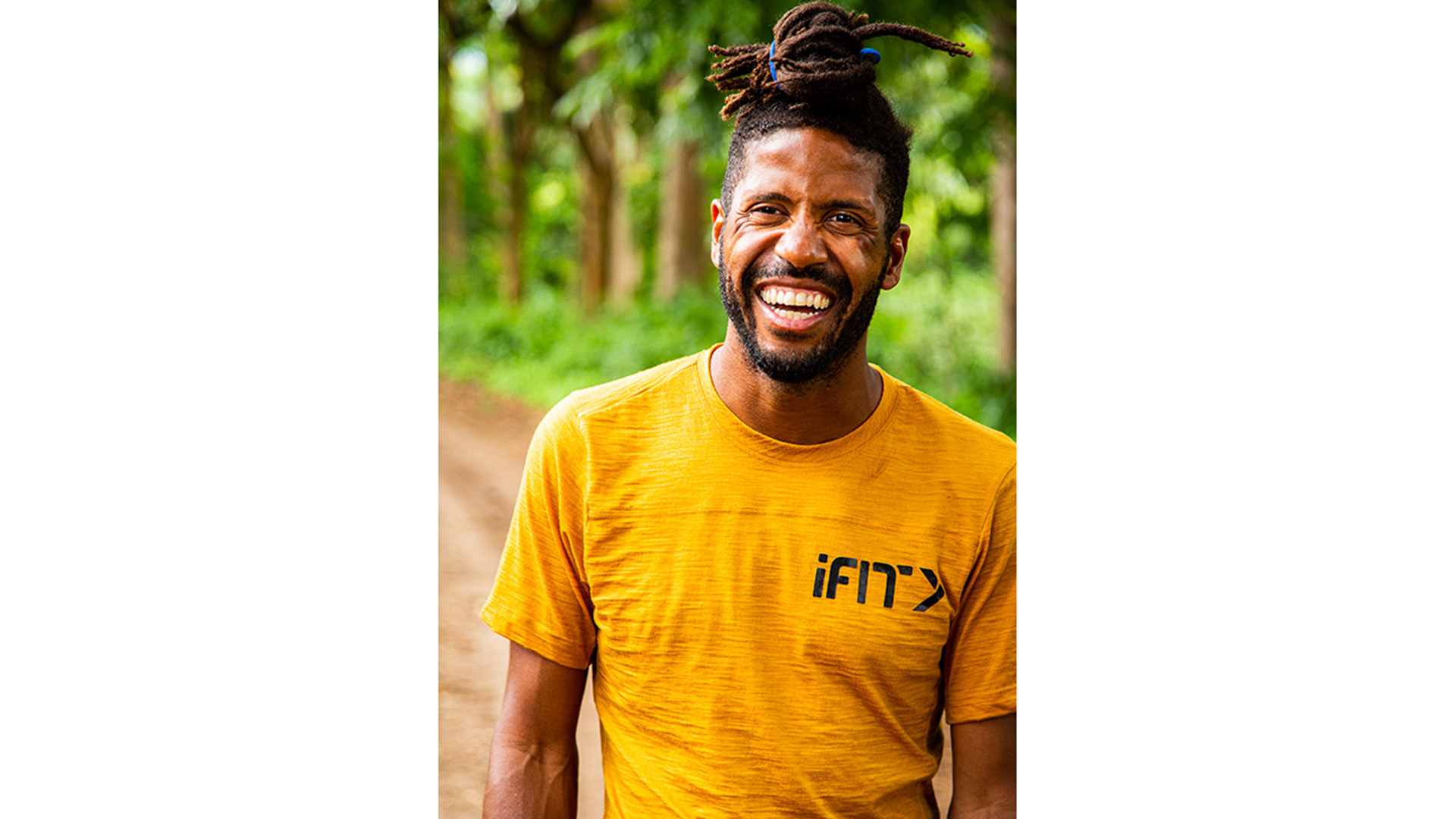

iFIT has a wealth of talented trainers at its disposal but none have quite the style and charisma of Knox Robinson. The New York native has chalked up nearly 100 videos on the platform, with series visiting South Africa, Keyna, Mexico City and many more. His authentic and relaxed style has made him a popular choice for new and advanced runners alike, both on the iFIT platform and beyond.
His Foundations of Running iFit series traces the routes of the sport, visiting many of the African nations where some of the best runners on the planet have come from. He also founded the Black Roses NYC running crew back in 2013, which promotes the culture and lifestyle of running in downtown New York City.
Having been an iFIT user myself for a few years on NordicTrack treadmills, I was keen to find out more about how Robinson approaches his training sessions and the advice he would give those looking to either start or take their running up a notch in 2024.
Rate of perceived exertion
One of the main measurements used across all iFIT workouts is the rate of perceived exertion or RPE. This allows runners, as well as cyclists and rowers, to put in an effort relative to their ability rather than try to hit a certain speed.
“RPE is great because it is a metric to get us to learn how to run on feel,” says Robinson. “It's an incredibly instructive tool from day one that we can use to understand what's happening with our own bodies and minds, which on a high level is part of the promise and the potential of the iFit platform, but mostly what it can mean for our fitness journeys.”
The level of RPE is personal – your RPE, won’t be the same as my RPE, or your iFit trainer’s RPE, but the relative level of effort will be the same. The RPE scale on iFit runs from one to 10, with warm-up jogs normally around a four, steady runs at a five or six, and faster sprints hitting an eight or nine. Some trainers break this down by heart rate, for instance, a five RPE is considered a maximum of 77% of your maximum heart rate (220 minus your age multiplied by 0.77 will give you this).
You can use the iFit heart rate sensor that attaches to your machine and automatically keeps you in the right RPE based on your heart rate. Watches, such as the Apple Watch will also show its zonal system that works similarly – though out of five.
Get all the latest news, reviews, deals and buying guides on gorgeous tech, home and active products from the T3 experts

Starting your fitness journey
The biggest challenge for any fitness journey is often how to start. So I asked Knox how to do it. “Not to take all the oxygen out of the room, but it is just putting one foot in front of the other,” says Robinson. “I get it. I live in the world and I have a litany of reasons why I can't do this or can't do that.
One of Knox’s big inspirations though was Kenyan long-distance runner, Eliud Kipchoge. “I was there in Monza in 2017 when he first attempted a two-hour marathon and fell just short by 26 seconds,” says Robinson. “It was incredible. As he crossed the line, it started to rain and I had to put my sunglasses on because I started to cry. My first thought was, wow, what's holding me back? What are the excuses that I'm holding onto? What can I let go of to break a barrier for myself?”
Whether you’re a champion runner or someone figuring out how to start a fitness journey, Knox says it’s important to understand the barriers, but know there is a path forward and that it does begin with putting one foot in front of the other. “That expression, we make the road by walking. I like to say we make the road by jogging,” adds Robinson.
For those who already run, taking it to the next level can also be a challenge. According to Knox, whether you’re aiming for a 5K, 10K or more, consistency is key. “It's unromantic and I've tried to put lipstick on it over the years, but I'm always going to tell you the truth,” says Robinson.
That doesn’t necessarily mean running every day. In fact, according to Knox, part of the journey is understanding what consistency means to you. “If the journey is significant, we have to follow that with consistency, but we also have to give ourselves grace,” says Robinson. “Giving yourself grace means withholding judgment. That's what I talk about in a lot of the series, hold back from judging yourself harshly, hold back from judging what's going on in your body.”
One of the great things about iFit is that it can almost distract you from the severity of your session, through the work of the trainers and stunning scenery. “What's incredible is that the scenery, the workout, unfolds in front of us as we experience together,” says Robinson. “We don't even know what the destination for each session is going to be. And so credit to iFit as a concept, credit to the filmmakers and the production team and the editors to create an episodic experience. Then the trainers help bring that to life, so shout out to my colleagues as well.

The music and rhythm of running
As with music, there’s a definite rhythm to running, and in the past, Knox has referenced that beat as similar to jazz. His challenge, he says was how to bring that to a session. “How do I bring that to someone who hates jazz?” Says Robinson. “How do I bring that idea with joy and curiosity and excitement to someone who honestly, maybe is cut off from life's music or is cut off from the musicality of their own body?”
When it comes to listening to music though, Knox finds that it sometimes adds that needed motivation and that low-tempo music can really speed you up. “Once I listened to The XX while running and looked at my watch and the time was very fast,” says Robinson. “I was like, wow, the XX will make you run really hard and really fast. And I was like, oh, we're definitely doing this tempo run.”
Other times though, such as for a competition, he needs to not listen to music to prepare himself mentally. “I went out to the Comrades Marathon in South Africa last year for the third time,” says Robinson. “It’s a 56-mile ultramarathon race and a friend that I usually travel with couldn't go at the last minute. So I was just there by myself and I didn't even have any support on the course. This is about to be me running 56 miles in South Africa by myself, I mean, albeit surrounded by the most amazing people on the planet. But yeah, no music. I was just like, let me just go and be with myself for eight, nine, almost 10 hours on that race.
Mindfulness in running
Whether you’re looking to run five or 10k, or an ultra marathon, the process is the same. Knox says that rather than the distance, it’s actually the space that’s hard. “I was talking with an athlete and he was like, ah, the marathon's such and such until mile 22. And then it got really rough, and I started thinking about all my life decisions and all the bad things I did in fifth grade,” says Robinson. “And I was like, well, now you know what you have to work on, not just mile 22. It's your presence of mind and your mindfulness in this section.
According to Knox, the reason ultra distances are more intense is because of the space to fill. “That's why in some of the longer series, you'll notice sometimes I just don't say anything and leave with you your heartbeat,” says Robinson. “But I do that at the end of the series when we've built the momentum, we've built the trust. For you and I to run in silence for 10 minutes is a very intense and galvanizing spiritual experience.”
While many of the iFit trainers have produced videos from locations known for mindfulness and meditation, Knox adds a moment of mindfulness at the start of his workouts, giving users a minute to walk in silence and reflect on their thoughts. “I really started bringing that mindful moment into the workouts just to hang my shingle out there,” says Robinson. “I mean, the ideas are real and it's part of my own personal practice, but I was like, lemme put this in part of the workout.”
This method is perfect for someone like me who’s not a fan of a shouty trainer, telling you to give it 110%. Starting with 60 seconds of silence is almost the complete opposite to that and it’s part of what makes iFit and trainers like Knox Robinson so interesting.
“That’s what’s cool about iFit, it’s actually rewriting the whole thing,” says Robinson. “The machines are incredible, the trainers are incredible, the community is incredible. The locations are epic. All those constituent parts are rewriting the whole connected fitness narrative. So if we're doing that, if we're writing a new code, why wouldn't we bring our best innovations to the practice starting with a mindfulness practice that's commensurate with a fitness journey?”
You can find Knox Robinson’s training sessions on iFit.com and compatible machines, from brands including NordicTrack, Pro-Form, Freemotion, Wieder and Matrix.

As T3's Editor-in-Chief, Mat Gallagher has his finger on the pulse for the latest advances in technology. He has written about technology since 2003 and after stints in Beijing, Hong Kong and Chicago is now based in the UK. He’s a true lover of gadgets, but especially anything that involves cameras, Apple, electric cars, musical instruments or travel.